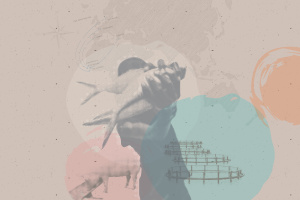Krill, Baby, Krill: The corporations profiting from plundering Antarctica

Executive summary
Antarctic krill is a cornerstone of the entire Antarctic ecosystem. Much of the marine life in the Southern Ocean is either a direct predator of krill or just one step removed, meaning that many animals – including whales, penguins, seals and squid – are dependent on krill as a crucial food source.
Because of global warming, the Southern Ocean is already experiencing important changes affecting temperature, sea-ice dynamics and currents, and their cumulative impact on the marine ecosystem is predicted to increase considerably during the present century. The latest 2022 Intergovernmental Panel for Climate Change (IPCC) report found that these changes to the west of the Antarctic Peninsula are already altering krill, questioned the viability of supply chains and advised industry players to explore alternatives, such as microalgae.
Numerous studies have demonstrated how targeted krill-fishing activities are exacerbating existing threats towards krill and the predators that feed on them. A key concern is not how much krill gets fished but rather where that fishing is conducted. Conservationists have been ringing the alarm bell for years about how fishing activities are concentrated in very small areas. This concentrated krill fishing overlaps with foraging areas for key species, such as penguins and seals, who then have to compete with fishing vessels for food.
This is unlikely to change, as fishing activities in the past decade are intensifying. Only five countries (and a total of about 12–14 vessels) are involved in krill fishing in the region, with Norwegian company and market leader Aker BioMarine taking 65% of the catch in 2021. However, catch levels have increased over the past decade, and authorised catch limits in some areas have been reached much quicker in the past few years. These trends are likely to get worse; more players have expressed interest in joining the fishery, and current actors have announced their intention to increase production. Meanwhile, the Commission for the Conservation of Antarctic Marine Living Resources (CCAMLR), responsible for managing the krill fishery, has repeatedly failed to reach a consensus on more protective measures for krill and local ecosystems.
Exposing murky krill-supply chains
Two main krill-based end products are now dominating the market: krill meal (largely used as feed additives in the aquaculture industry) and krill oil (extracted mostly to produce Omega-3 dietary supplements).
Changing Markets’ survey of the 50 largest retailers’ online stores shows how widely krill-based health supplements are still available around the world. Globally, of the 50 largest retailers that sell health supplements:
1. 68% (34 retailers) were found to sell krill-oil products;
2. 88% of the 17 North American retailers and 75% of the 8 Asian retailers included sell krill-oil supplements; and
3. Nearly half of the 21 European retail chains included sell krill-oil health supplements.
Krill meal is much harder to trace than krill oil; it is mostly used as one of many ingredients of fish meal in aquaculture, an industry that suffers from an endemic lack of transparency. Yet a detailed investigation of a sample of 16 European retail chains in France, Germany, Spain and the UK revealed that all of them are likely to sell products from salmon that were reared on feed containing krill:
1. Similar to the use of wild-caught fish, none of the retailers have developed sourcing policies that exclude the use of krill feed for their farmed seafood. Salmon products in Aldi Nord, Edeka, Kaufland and Lidl (Germany); Auchan, Carrefour, Intermarché and Leclerc (France); Carrefour, Dia, Lidl and Mercadona (Spain); and Asda, Marks & Spencer, Sainsbury’s and Tesco (UK) were found to have links to krill meal. In all cases, the krill meal within these retailer supply chains originates from the biggest market player: the Norwegian company Aker BioMarine.
2. Further upstream in the supply chain, the investigation also found that five of the largest European companies farming salmon (Bakkafrost, Cermaq, Grieg Seafood, Lerøy Seafood and Norway Royal Salmon) use krill meal, which is likely sourced from Aker BioMarine, for at least some of their salmon production.
3. The world’s largest salmon company, Mowi, as well as SalMar and Cooke Aquaculture, appear not to be using krill-based feed.
4. Finally, the investigation also found that two (BioMar and Skretting) of the four aquafeed companies that dominate the global aquaculture feed market add krill meal to their feed products and source the krill from Aker BioMarine, while the other two (Mowi and EWOS) do not seem to use krill meal.
PARTNERS

You might also like...

Until the Seas Run Dry: How industrial aquaculture is plundering the oceans
This report shines a spotlight on the environmental and social impacts of reduction fisheries - the use of wild-caught fish in fishmeal and fish oil to feed farmed fish.

Feeding a Monster: How European aquaculture and animal industries are stealing food from West African communities
This report uncovers how each year, over half a million tonnes of wild-caught fish are taken out of the oceans around West Africa and ground down into fishmeal and fish oil to feed farmed fish and animals.

Überfischung: Wildfisch als Fischfutter in Aquakulturen – Schweizer Detailhändler im Vergleich
This report outlines how effectively Swiss retailers are safeguarding the health of the oceans and fish welfare through the sustainability of their aquaculture supply chains. Read our German language report: